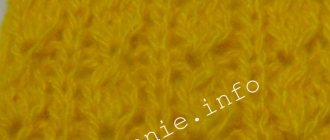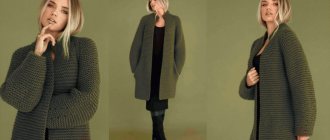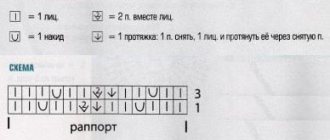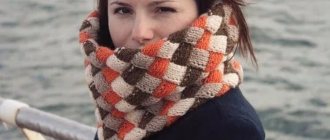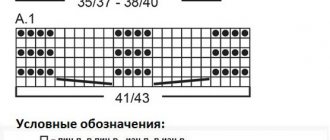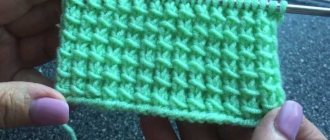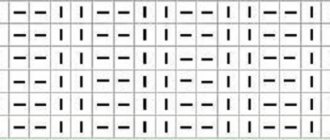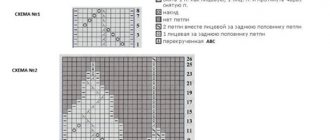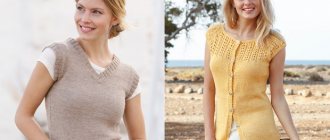Lazy jacquard "chicken foot"
We adhere to the proposed scheme:
We dial the number of stitches, a multiple of 6, plus 2 edge stitches.
1 rub. (B): * remove 1 p., n. behind knitting, 5 l. P.*.
2 r. (B): *5 i. p., 1 p. sn., n. front knitting*.
3 r. (H): *5 l. p., 1 p. sn., n. behind knitting*.
4 rub. (H): *1 p.sn., n. front knitting, 5 and. P.*.
5 rub. (B): *3 p.sn., n. behind, 1 l. p., 1 p. sn., n. behind knitting, 1 l. P.*.
6 rub. (B): *1 i. p., 1 p. sn., n. front, 1 and. p., 3 p. sn., n. front knitting*.
7 rub. (H): *3 l. p., 1 p. sn., n. behind knitting, 2 l. P.*.
8 rub. (H): *2 i. p., 1 p. sn., n. front knitting, 3 and. P.*.
9 rub. (B): *2 l. p., 1 p. sn., n. behind knitting, 3 l. P.*.
10 rub. (B): *3 i. p., 1 p. sn., n. front knitting for women 2 and. P.*.
11 rub. (H): *3 l. p., 3 p. sn., n. behind*.
12 rub. (H): *3 p.sn., n. front, 3 i. P.*.
Jacquard without broaches "zigzag" for women
We adhere to the proposed scheme:
We dial the number of p., a multiple of 6 plus 2 edges.
1 rub. (dark): *1 p.sn., n. rear, 2 l. P.*.
2 r. (dark): *2 i. p., 1 p. sn., n. ahead*.
3 r. (light): *1 l. p., 1 p. sn., n. rear, 3 l. p., 1 p. sn., n. behind behind*.
4 rub. (light): *1 p.s.n., n. ahead, 3 and. p., 1 p. sn., n. ahead, 1 and. P.*.
5 rub. (dark): *2 l. p., 1 p. sn., n. rear, 1 l. p., 1 p. sn., n. rear, 1 l. P.*.
6 rub. (dark): *1 and. p., 1 p. sn., n. ahead, 1 and. p., 1 p. sn., n. ahead, 2 and. P.*.
7 rub. (light): *1 p.s.n., n. rear, 2 l. p., 1 p. sn., n. rear, 2 l. P.*;.
8 rub. (light): *2 i. p., 1 p. sn., n. ahead, 2 and. p., 1 p. sn., n. ahead*.
9 rub. (dark): *1 l. p., 1 p. sn., n. rear, 3 l. p., 1 p. sn., n. behind*.
10 rub. (dark): *1 p.sn., n. ahead, 3 and. p., 1 p. sn., n. ahead, 1 and. P.*.
11 rub. (light): *2 l. p., 1 p. sn., n. behind, 1 l. p., 1 p. sn., n. behind, 1 l. P.*.
12 rub. (light): *1 and. p., 1 p. sn., n. p.r., 1 i. p., 1 p. sn., n. front, 2 and. P.*.
Knitting openwork Christmas trees
The pattern consists of twelve loops. Following the pattern, the pattern is repeated from the first row to the twentieth. In the inner rows, loops are knitted according to the pattern of the material, and yarn overs are knitted on the wrong side.
Both loops, including the outer one, are knitted towards the right side. This pattern will look beautiful in both dark and light shades.
NOTE!
- Knit a tunic - simple patterns and recommendations for choosing models for children and adults (130 photos)
- Knitted overalls for newborns - knitting pattern and description of sewing the best modern models (105 photos)
How to knit a rug - detailed instructions and diagrams on how to properly knit a neat, beautiful rug
Unusual jacquard patterns for women
We adhere to the proposed scheme:
We cast on a number of stitches that is a multiple of 6 plus 4 symmetry stitches and 2 edge stitches.
1, 2, 5 and 6 rubles. (green): l. P..
3 r. (pink): *1 stitch, thread at work, 5 l. p. with two turns *, 1 p. dc., thread at work, 3 l. p. with two turns.
4 rub. (pink): from 3 p. we knit 3, 1 p. dc, n. p. work * from 5 p. we knit 5, 1 p. dc, n. etc.*.
7 rub. (pink): 3 l. p. with two turns, * 1 p. sn., n. per r., 5 l. p. with two turns *, 1 p. sn., n. for r..
8 rub. (pink): 1 p. dc, n. p.r., *from 5 p. we knit 5, 1 p.sn., n. p.r.*, from 3 p. we knit 3.
Popular “snowflake” pattern without broaches
To knit a snowflake without broaches, you will need a pair of contrasting threads made from similar yarn, which should be of optimal quality.
At the beginning of the work, you should cast on twenty-five loops, twenty-three of them with knitting needles, and the other two with edge stitches. The edge loop that closes the row is pierced simultaneously with two shades of thread.
Subsequent knitting of other rows should occur in the same way as described above, i.e. with the obligatory closure of the edge loops.
Thanks to this, the product will maintain thread tension on all sides, and there will also be a chance to prevent vertical broaching on it.
When starting to work on the outside, remove the edge loop. After this, alternating with each other, two threads will be used simultaneously in the process.
As shown in the photo, the first loop is pierced with yellow thread. In order to prevent broaches, the yellow thread is tied from the opposite side, as if representing the tying of blue yarn, despite the fact that it is located closer. The product becomes denser precisely due to the threading of the loop and the tightening of both threads.
NOTE!
How to crochet a flower to decorate clothes: diagrams with explanations and photo ideas of flowers for clothes (80+ photos)The best options for DIY knitted hats: step-by-step instructions and tips
How to knit a shirtfront simply and beautifully with knitting needles for children, women and men: useful tips and instructions (80+ photos)
After these manipulations, you can start knitting with blue thread. Compared to the yellow thread, the blue thread is further away from the needle.
To create such a loop, you should bring the knitting needle under the right side, where the yellow thread is located, while hooking and tying the blue thread.
The following steps for knitting a product without broaches should not be particularly difficult. To do this, you must adhere to the above instructions, focusing on the images of knitted jacquard patterns using knitting needles.
Double-sided jacquard patterns
This pattern is knitted exclusively with circular knitting needles and is perfect for hats, scarves and vests.
We cast on a number of stitches that is a multiple of 8, plus 7 symmetry stitches and 2 edge stitches.
1 rub. (pattern, red): 1 p.sn., n. forward, *1 l. p., 1 p. sn., n. forward*.
2 r. (wrong side, gray): 1 l. p., *1 p. sn., n. forward, 1 l. P.*. The red thread remains on the other side of the product.
3 r. (knot, gray): *1 and. p., 1 l. p., 1 i. p., 1 l. p., 1 i. p., 1 l. p., 1 i. p., 1 p. sn., n. back.*, 1 and. p., 1 l. p., 1 i. p., 1 l. p., 1 i. p., 1 l. p., 1 i. p.. At the end of the row, the red and gray thread should be on one side of the product.
4 rub. (wrong side, red): 1 p.sn., n. back., *1 and. p., 1 p. sn., n. back.*. We move the stitch to the other end of the knitting needle.
5 rub. (wrong side, gray): 1 l. p., *1 p. sn., n. forward, 1 l. P.*. At the end of the row, the red and gray threads are on one side of the work.
6 rub. (knot, gray): *1 and. p., 1 l. p., 1 i. p., 1 l. p., 1 i. p., 1 l. p., 1 i. p., 1 p. sn., n. back.*, 1 and. p., 1 l. p., 1 i. p., 1 l. p., 1 i. p., 1 l. p., 1 i. p.. Move the loops to the other end of the knitting needle.
Knitting lessons two-color patterns
How to knit two-color patterns with knitting needles?
Photos, instructions, descriptions and knitting patterns will help you get the job done. With the help of multi-colored knitting patterns, it is easy to create excellent bright knitted fabrics. Using the techniques described below, you can create stunning knits in checks, stripes, zigzag or mesh patterns, and tweed-effect fabrics. Even when using more than three or four colors in a pattern, the row is always done with thread of the same color. When knitting two-color patterns with knitting needles, the result is a fairly dense knitting, which is perfect for making jumpers, jackets and other outerwear.
Jacquard knitting "chain" for women
We adhere to the proposed scheme:
We cast on the number of stitches, a multiple of 6 plus 2 edge stitches.
1 rub. (white): *5 l. p., 1 p. sn., n. per r.*.
2 r. (white): *1 p.s.n., n. before r., 5 i. P.*.
3 r. (green): *1 p.s.n., n. per r., 1 l. p., 1 p. sn., n. per r., 3 l. P.*.
4 rub. (green): * 3 and. p., 1 p. sn., n. in front of the river 1 i. p., 1 p. sn., n. before r.*.
5 rub. (white): 3 l. p., *5 l. p., 1 p. sn., n. per rub.*, 2 l. P..
6 rub. (white): 2 and. p., *1 p. sn., n. before r., 5 i. n.*, 3 i. P..
7 rub. (green): 1 p. dc, n. per r., 3 l. p., *1 p. sn., n. per r., 1 l. p., 1 p. sn., n. per r., 3 l. p.*, 1 p. sn., n. per r., 1 l. P..
8 rub. (green): 1 and. p., 1 p. sn., n. before r., *3 i. p., 1 p. sn., n. in front of r., 1 i. p., 1 p. sn., n. before r.*, 3 i. p., 1 p. sn., n. before r..
9 rub. (white): 1 l. p., 1 p. sn., n. per rub., *5 l. p., 1 p. sn., n. per rub.*, 4 l. P..
10 rub. (white): 4 and. p., *1 p. sn., n. p.r., 5 i. p.*, 1 p. sn., n. p.r., 1 i. P..
11 rub. (green): 2 l. p., *1 p. sn., n. per r., 1 l. p., 1 p. sn., n. per r., 3 l. p.*, 1 p. sn., n. per r., 1 l. p., 1 p. sn., n. per r., 1 l. P..
12 rub. (green): 1 and. p., 1 p. sn., n. p.r., 1 i. p., 1 p. sn., n. p.r., *3 i. p., 1 p. sn., n. p.r., 1 i. p., 1 p. sn., n. p.r.*, 2 i. P..
Women's Two Tone Lazy Jacquard
We adhere to the proposed scheme:
The number of stitches is a multiple of 4 + 2 edges.
We knit 1 row with red thread. l. p. and 1 more p. And. etc., then we proceed to the rows that we will alternate.
1 rub. (blue): *3 l. p., 1 p. red sn., blue thread for r.*.
2 rows: (blue): we knit blue sts as well. p., red p. again sn., blue p.r..
3 r. (red): *1 l. p.., 1 p. blue dn., without knitting, red n. for r, 2 l. P.*.
4 rub. (red): we knit red sts as well. n., blue dn., red n. p.r.. Repeat 1-4 r..
Video lesson
To help beginners knit a jacquard pattern with knitting needles, you can take the help of professional knitters who show in detail each manipulation of the knitting needles with threads. This Norwegian motif will look great on women's, men's and children's clothing. It is especially convenient that this jacquard pattern is knitted in the round and is obtained without broaches.
Video: how to knit a beautiful jacquard pattern with knitting needles
Share with your friends!
- 22
- 25
- 13
- 60
Shared
Subscribe to our Yandex.Zen channel or Yandex.Messenger
Delicate jacquard patterns for women
The number of stitches is a multiple of 4 plus 2 edge stitches. In all rows we make the first edge knit, and the last - purl.
1 p.: (white): *1 i. p., 1 l. p.*, from * to *.
2 p.: knit sts according to the drawing. To switch to red chrome. we knit together with threads of two colors..
3 rubles: *1 l. p., 1 i. p., 1 l. p., 1 p. sn., n. back.*., from * to *, 3 and. P.
4 p.: * 1 p. sn., n. forward, 1 and. p., 1 l. p., 1 i. p.*, white p. d.c., and make red ones according to the figure. We switch to a white thread.
5 rubles: *1 i. p., 1 l. p., 1 i. p., 1 l. P.*.
6 rubles: knit according to fig. rap. *1 i. p., 1 l. p., 1 i. p., 1 l. p.*, change color.
7 rubles: *1 l. p., 1 p. sn., 1 l. p., 1 i. P.*.
8 rubles: *1 l. p., 1 i. p., 1 p. sn., 1 i. P..
Lazy knitting patterns with diagrams: instructions with description
Today we will look at how you can use lazy patterns with lists with patterns for making slippers, as well as other variations of patterns. This type of work is also well suited for those who love creativity, whose skill level has not risen above a beginner.
Master class on making slippers with a lazy pattern
Slippers are practical house shoes that are suitable for people of all ages. They can also be knitted using lazy patterns. Let's consider the entire process of work with the description so that in the end they turn out like in the photo:
For size 37 you will need:
- Yarn (wool 20% and acrylic 80%) – 135 meters/50 g. Also light gray – 30 g and brown – 40 g;
- Five knitting needles No. 3;
- Scissors.
Let's use a knitting density of 2.2 loops per 1 cm.
If you already have knitting skills on five needles, then such slippers will not cause you a lot of problems.
Step-by-step instructions for work:
- We cast on 56 loops on two knitting needles.
- Then, using stockinette stitch, we distribute 14 stitches on the knitting needles and knit 10 rows with brown thread.
- We attach the light thread and begin to knit in height.
- We make the heel the same way as the toe, only we make its height a little larger (by 1 cm). The heel height is 32 rows. Also unlike a regular sock, here we start knitting the heel from the front side, not the back side.
- After the heel, we distribute 9 loops on the side parts, and 10 on the middle part. The loops were removed on the front and back sides using classic knitting.
- In the 33rd row we knit 9 loops on the right side, then 9 in the middle and the 10th loop together with the first right side.
- We turn the product over again and change the color of the thread. Since the thread remained at the edge on the right, it can be cut and reattached, or simply thrown to the desired place.
- We continue to knit the heel when it is formed, we make the central part in brown and lift it from the side loops from each edge. For convenience, it is better to knit with a smooth crochet.
- And so, we got it: 16 loops raised on the left, 15 loops on the right. The row where we raised the loops will be considered the first row of the main part.
- We knit the main part in a circle, so we knit the second and remaining rows with purl loops.
- Since there are more loops on the side parts, we cut off the extra ones by knitting two loops together at the beginning of the third knitting needle and at the end of the 4th.
- In the third row we shorten by knitting 2 stitches together at the end of the fourth needle, so we align the sides.
- And from the 4th row we already make 2 reductions until there are 28 loops left for the bottom of the sock. At the same time, do not forget to monitor the drawing so that it does not go astray.
- Having completed the middle part, we knit the toe according to the same principle as a simple sock. There are 53 loops to the cape.
- In the 54th row we knit the last two loops together on the fourth knitting needle. On the first knitting needle we knit 2 and 3 loops together.
- On the other side we do the same.
- We continue to decrease across rows until half the stitches remain.
- We continue decreasing, but in each row, until there are 6 loops, which we tighten with thread.
- The work is ready.
The heel will look like in the photo:
Now let's look separately at how to knit a lazy pattern directly.
Master class on knitting a lazy pattern (lazy jacquard)
The pattern we used to create the slippers is two-tone. It is often used in clothing, as well as for children's items, such as sweaters or hats. The fabric is dense and holds its shape well.
Learning to knit a pattern:
- 1 row, for example, in gray: one front loop, remove 1 loop, the thread remains at work.
- In the second row we use the same color and knit all the stitches.
- The third row, already in burgundy color: we remove one loop, the thread remains at work, then we knit one front one.
- We knit the burgundy fourth row with knit stitches.
You can use the pattern to knit this pattern with the stitches removed:
The following images are used in the diagram:
- An empty square indicates knit stitches in a knit row or purl stitches in a purl row.
- The purl loops are indicated by a square with a circle inside.
- A striped square indicates the need to remove an unknitted loop from the left to the right needle. In this case, the working thread remains behind.
There are many more different patterns knitted using the lazy jacquard technique. For example, a snail is a very interesting pattern:
Video on the topic
There are many variations of things that use the technique of knitting a lazy pattern with knitting needles, which is used in the manufacture of hats, slippers, sweaters and other wardrobe items. Many people find it easier to learn the basics of work if they see a visual image. Therefore, in addition to the diagrams presented in the article, we have prepared video materials for you that may be useful in your work. Enjoy watching!
[media=https://vse-sama.ru/images/stories/faq/len_or4.jpg]
sdelala-sama.ru
Jacquard patterns for beginners
Purl everything. pp. knit the same way: sn. n. we remove (the thread above the work), the rest as well. P..
We always knit the edges, and when changing the thread we re-knit them with a new color.
We dial 20 p. plus 2 chrome. P..
1 rub. (black): l. P..
3 r. (beige): knit the chrome with a new color. p. and the first p., then 1 p. (n. behind the product), 3 l. p.,), knit 3 and so on until the end of the p..
5 rub. (black): 3 l. p., 1 p. (light) sn. and so on until the end...
7 rub. (black): l. P..
9 rub. (light): shift the drawings - 3 l. p., 1 p. sn. and so on until the end of the r.. Then we alternate 5-9 r..
If you want to make a drawing not in a checkerboard pattern, you do not need to make an offset, just start with the diagram of the first row..
How to knit lazy patterns using knitting needles according to the pattern: a detailed description for beginners
Knitting so-called “lazy patterns” has recently become very popular among needlewomen. These patterns are called lazy because they are very simple to perform; even those who are just beginning their acquaintance with knitting needles can easily cope with knitting this simple but effective pattern.
The most popular type of lazy patterns made with knitting needles is lazy jacquard. House slippers decorated with a lazy jacquard pattern will serve as an original gift, and making them will not take much time and effort. The technique of knitting “lazy jacquard” using a ready-made pattern is very simple, the main thing is to understand the basic principles of knitting “lazy” patterns. Lazy patterns: knitting
Contents of the material
Lazy knitting patterns: where to start
Getting acquainted with the technology of knitting lazy patterns, and, in particular, mastering the specific technique of knitting “lazy jacquard”, it is recommended to begin with a careful study of ready-made patterns of ornaments. On the Internet and specialized literature devoted to knitting, there are a large number of different patterns for making lazy patterns of varying levels of complexity. One of the simplest techniques for making these patterns is lazy jacquard. Beginning needlewomen who are still comfortable with knitting needles are recommended to start mastering jacquard by knitting cozy, elegant house slippers. It is recommended to choose the simplest diagram, with a detailed description of the work process and photographs of the finished product.
In order to knit slippers using the lazy jacquard technique, you will need:
- A measuring tape to measure the circumference of your leg.
- Knitting pattern for house slippers with a detailed description of the work. It is advisable to choose the simplest pattern of slippers with a pattern of rye in two colors. Before starting work, you must carefully study all the symbols indicated on the diagram and read the description attached to the diagram. If something is unclear in the diagram, you definitely need to find out or choose a simpler diagram.
- Knitting needles. The number of knitting needles (as well as color and yarn number) is usually indicated in the description of the work process.
- Yarn in two colors. The pattern of alternating colors is quite simple. It is advisable that these be contrasting colors, then the patterns will look more impressive. In different patterns, beginning craftswomen are offered a variety of color combinations; the choice depends entirely on the individual tastes and preferences of the craftswoman.
Slippers with lazy jacquard: general description of work
House slippers, knitted using lazy jacquard patterns, resemble socks. They are often called that: socks-slippers. But, unlike ordinary knitted wool socks, the lazy jacquard technique allows you to knit an elastic and hard fabric that holds the shape of the leg well. Therefore, such slippers are not only beautiful, but also comfortable. Unlike other types of soft indoor slippers, walking in such shoes will not cause flat feet, since the knitted sole is quite hard.
You need to start work by taking measurements. Having measured the girth of her leg, a beginning knitter should calculate the required number of loops for one slipper, just as is done when making ordinary socks.
The knitting process is in many ways similar to knitting classic socks. The upper edge of the slippers is knitted in stockinette stitch and shaped into a tight roller. The two-color checkered pattern looks very impressive. First you need to knit the main part of the slipper using the principle of circular knitting. The next stage is performing the heel part. The main difficulty of the work is that the craftswoman must continuously monitor the correct sequential alternation of two colors, otherwise the drawing will go astray and the work will be ruined.
Knitting lazy patterns: practical recommendations
In order to easily get used to knitting lazy patterns and make elegant house slippers, a novice craftswoman should practice a little in knitting ordinary woolen socks. This will help you understand the general principle of knitting hosiery, including soft slippers. It is also necessary to keep in mind important practical recommendations:
We also recommend reading:
- The basis for knitting any hosiery (socks, stockings, knitted tights, baby booties, soft slippers) is the principle of circular knitting. Therefore, before you start knitting soft slippers, you should practice knitting in the round.
- It is necessary to ensure that the knitting density is the same all the time. Only in this case can you end up with a fairly hard knitted fabric that holds its shape well.
- In order for the slippers to look impressive, and also to make it easier to follow the alternation of two colors, contrasting colors should be chosen for knitting with lazy jacquard. White will look most impressively elegant in combination with any other color: white red, white and gold, and for men - the classic, strict black and white version.
- If the finished slippers are intended for a woman or child, after completing the main work, the knitted shoes can be decorated. Bright ribbons, tassels or pom-poms are perfect for this. However, slipper-socks made using lazy jacquard look elegant on their own due to the beautiful pattern and do not require additional decoration. Decor is a matter of taste.
Cozy, warm soft house shoes are an irreplaceable gift for family and friends. These slippers will definitely be appreciated by elderly parents, as well as grandparents. Even an inexperienced needlewoman can easily knit slipper socks using the “lazy jacquard” pattern, the main thing is patience, attentiveness and desire. Finished shoes will last a long time and will help keep you warm in the most severe frosts. Sock slippers look beautiful, are comfortable and have not gone out of fashion for many years. Knitting house shoes is a great hobby that can become a profession.
Attention, TODAY only!
1igolka.com
Lazy jacquard "snake"
We adhere to the proposed scheme:
We dial the number of p., a multiple of 4, plus 2 chrome. P..
1 rub. (brown): *3 l. p., 1 p. remove., n. per r.*.
2 r. (brown): *1 p.s.n., n. p. viscous, 3 i. P.*.
3 r. (ser.): *2 l. p., 1 p. sn., n. per knitting, 1 l. P.*.
4 rub. (ser.): *1 i. p., 1 p. sn., n. p. viscous, 2 i. P.*.
5 rub. (brown): *1 l. p., 1 p. sn., n. per knitting, 2 l. P. *.
6 rub. (brown): *2 i. p., 1 p. sn., n. p. viscous, 1 and. P.*.
7 rub. (ser.): *2 l. p., 1 p. sn., n. per knitting, 1 l. P.*.
8 rub. (ser.): *1 i. p., 1 p. sn., n. p. viscous, 2 i. P.*.
Simple lazy jacquard for women
We adhere to the proposed scheme:
The number of items is a multiple of 10 + 2 chrome. P..
1, 5 and 9 pp. (blue): *5 l. p., 1 p. sn., n. per elm, 1 l. p., 1 p. sn., n. per elm, 1 l. p., 1 p. sn., n. for elm.*.
2, 6 and 10 pp. (blue): *1 p.s.n., n. p. elm., 1 i. p., 1 p. sn., n. p. elm., 1 i. p., 1 p. sn., n. n. elm., 5 i. P.*.
3, 7, 11, 15, 19, 23 rub. (white): l. P..
4, 8, 12, 16, 20, 24 rub. (white): i. P..
13, 17, 21 rr. (burgundy): *1 p.sn., n. per r., 1 l. p., 1 p. sn., n. per r., 1 l. p., 1 p. sn., n. per r., 5 l. P.*.
14, 18, 22 rub. (burgundy): *5 and. p., 1 p. sn., n. p.r., 1 i. p., 1 p. sn., n. p.r., 1 i. p., 1 p. sn., n. etc.*.
Drawing "squares"
Schematic illustration
We collect the number of points, cr. 6.
We knit 4-6 rr. stitch stitch and proceed to the “chain”.
1 rub. (yellow): *5 l. p., 1 p. sn., n. per r.*.
2 r. (yellow): *1 p.s.n., n. p.r., 5 i. P..
3 r. (blue): *1 p.s.n., n. per r., 3 l. p., 1 p. sn., n. per r., 1 l. P.*.
4 rub. (blue): *1 and. p., 1 p. sn., n. p.r., 3 i. p., 1 p. sn., n. etc.*.
5 rub. (yellow): *2 l. p., 1 p. sn., n. per r., 3 l. P.*.
6 rub. (yellow): *3 and. p., 1 p. sn., n. p.r., 2 i. P.*.
7 rub. (blue): 1 p.sn., n. per r., 3 l. p., 1 p. sn., n. per r., 1 l. P.*.
8 rub. (blue): *1 and p., 1 p.sn., n. p.r., 3 i. p., 1 p. sn., n. etc.*.
9 rub. (yellow): *5 l. p., 1 p. sn., n. per r.*.
Knitting patterns and symbols.
Scheme No. 1. Front stitch.
The front row and all subsequent ones are facial loops.
Attention! Thus, the stockinette pattern is knitted only when knitting in the round.
Scheme No. 2. Elastic band 3×3.
1 row. *3 knit stitches, 3 purl loops*.
Knit the second and subsequent rows similarly to the first. Pattern repeat is 6.
Scheme No. 3. Zigzag pattern.
- Thread A tone 0475 “blue turquoise”. In the diagram the cells are white.
- Thread B tone 0335 “sea wave”. In the diagram, the cells are purple.
- The diagram shows the front and back rows.
- The pattern repeat is 12. Repeat from rows 1 to 16.
- Even rows in the pattern when knitting in the round are read from right to left.
Bricks
Schematic illustration
Number of items cr. 6 + 1 p. symmetry + 2 chrome. P..
1 and 7 pp. (ser.): l. P..
2 and 8 pp. (ser.): i. P..
3 r. (burgundy): 1 l. p., *3 l. p., 1 p. sn., n. per r., 2 l. P.*.
4 and 6 pp. (burgundy): *2 l. p., 1 p. sn., n. p.r., 3 l. p.*, 1 l. P..
5 rub. (burgundy): 1 i. n., *3 i. p., 1 p. sn., n. for r., 2 and. P.*.
9 rub. (Bordeaux): 1 l. p., *1 p. sn., n. per r., 5 l p.*.
10 and 12 pp. (Bordeaux): *5 l. p., 1 p. sn., n. p.r.*, 1 l. P..
11 rub. (Bordeaux): 1 and. p., *1 p. sn., n. for R., 5 and. P.*.
